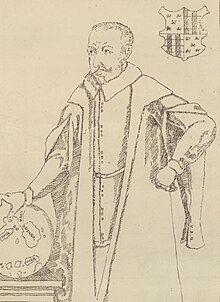Manuel Godinho de Erédia
Manuel Godinho de Erédia, or Emanuel Godinho de Erédia (16 July 1563 – 1623), was a Bugis-Portuguese writer and cartographer. He wrote a number of books, including an early account of the Malay Peninsula that is a source of information on the region of that period. In the early 17th century, he became interested in exploring a "southern land", which is thought to be Australia.
Life
Godinho de Erédia was the youngest of four children of João de Erédia Aquaviva, a Portuguese of Aragonese and Italian descent.[1] His mother was Dona Elena Vessiva from Sulawesi, a Bugis princess, the daughter of La Putebulu the recently baptized King of Suppa.[2][3][4][5] His father was part of a Portuguese missionary expedition to Sulawesi when he met the 15-year-old girl, who fell in love and eloped with the Portuguese captain, and they married in 1545. Manuel Godinho de Erédia was born on 16 July 1563 in Malacca where he also spent his childhood. He was educated at a Jesuit school there.[3][6]
His mother died in 1575, and soon after when he was 13, Erédia was sent to a Jesuit college in
Erédia married Vilante de Sampaio in
Career

Erédia worked as a
Erédia became interested in finding the legendary "land of gold", and returned to South East Asia in 1600 on a mission to explore further the


Erédia heard of a land to the south or
Works
Apart from his maps, Erédia left a diverse range of written work and drawings. His most significant book is Description of Malaca, Meridional India, and Cathay written in 1613, and it is a source of information on the early history of Malacca. None of his books were published in his lifetime.[9] Among his works are:[8][10]
- 1597–1600 — Report on the Golden Chersonese, or Peninsula, and Auriferous, Carbuncular and Aromatic Islands (a broad account of the Malay Archipelago); Report on Meridional India
- 1610 — Plantas de plaças das conquistas de Portugal
- 1611 — Discourse on the Province of Indostan, termed Mogûl
- 1612 — Summary of the Trees and Plants of India intra Ganges (Suma de árvores e plantas da Índia Intra Ganges)
- 1613 — Description of Malaca, Meridional India, and Cathay (Declaraçam de Malaca e da India Meridional com Cathay)
- 1615 — History of the Martyrdom of Luiz Monteiro Coutinho
- 1616 — Treatise on Ophir (Tratado Ophirico). An autobiography is included in this work.
- c. 1620 — Lyvro de Plataforma das Fortalezas da India (an illustrated accounts of Ormuz and Mozambique.[11])
See also
References
- ISBN 9781137447494.
- ^ "Jejak Kristen di Tanah Bugis". Tribun-timur.com (in Indonesian). 2013-12-28. Retrieved 2021-11-22.
- ^ a b c d e f Godinho de Erédia (April 1930). "Eredia's Description of Malaca, Meridional India, and Cathay" (PDF). Journal of the Malayan Branch of the Royal Asiatic Society. VIII, Part I. Translated by J. V. Mills.
- ISSN 1833-7538.
- ^ ISBN 9780674067363.
- ^ Boxer, Charles Ralph (1965). "Some Portuguese Sources for Indonesian Historiography". In Soedjatmoko, et al. (eds.). An Introduction to Indonesian Historiography. Ithaca, New York: Cornell University Press. pp. 217–233, and especially pp. 223–224.
- ISBN 9781137447494.
- ^ a b John N. Miksic (1998). "Review: Eredia's Description of Malacca, Meridional India, and Cathay. MBRAS Report No. 14 by J. V. Mills, Cheah Boon Kheng". Journal of the Malaysian Branch of the Royal Asiatic Society. 71 (2 (275)): 137–141.
- ISBN 9781137447494.
- ISBN 9780674067363.
- ISBN 978-0-7546-6313-3.
Further reading
- Borschberg, Peter, "Singapura in Early Modern Cartography: A Sea of Challenges", in Visualising Space. Maps of Singapore and the Region. Collections from the National Library and National Archives of Singapore (Singapore: NLB, 2015): 6-33. https://www.academia.edu/8681191
- Borschberg, Peter, "Three Early 17th-Century Maps by Manuel Godinho de Eredia", Journal of the Malaysian Branch of the Royal Asiatic Society, 92.2 (2019): 1-28.
- Gibson-Hill, Carl-Alexander, "Singapore: Note on the History of the Old Straits, 1580–1850", Journal of the Malayan Branch of the Royal Asiatic Society, 27.1 (1954): 165-214.

